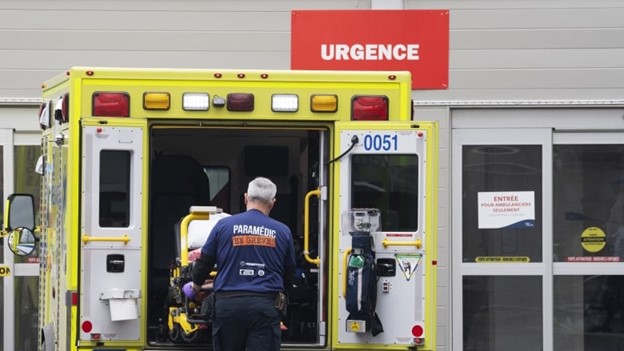Canadian emergency rooms are overflowing while an array of respiratory illnesses — COVID-19 included — keep circulating. And it’s happening against a backdrop of behind-the-scenes backlogs that turn frontline ERs into dangerous choke points. (Ryan Remiorz/The Canadian Press)
Staff shortages, respiratory illnesses pose challenges, alongside long-standing hospital bed capacity crunch
This story is part of CBC Health’s Second Opinion, a weekly analysis of health and medical science news emailed to subscribers on Saturday mornings. If you haven’t subscribed yet, you can do that by clicking here.
A newborn with a fever waited five hours to be seen by an emergency physician near Toronto.
Patients were surrounded by garbage and urine as they waited 18 to 20 hours for care at a hospital in Fredericton.
And in Alberta, Red Deer’s long-beleaguered hospital was forced to hang tarps to create makeshift treatment spaces.
Those headlines come from different hospitals and different provinces. But they all point to the same grim problem: Emergency rooms are overflowing while an array of respiratory illnesses — COVID-19 included — keep circulating. And it’s happening against a backdrop of behind-the-scenes backlogs that turn front-line ERs into dangerous choke points.
The numbers are staggering. More than 10,000 people are in hospital at once across B.C., the most the province has ever seen, while Quebec grapples with the highest level of patients in its emergency rooms in five years.
In Ottawa, the Queensway Carleton Hospital recently said it was operating at 115 per cent occupancy. By midweek, most Montreal emergency rooms were above full capacity, with some operating at roughly 200 per cent.
The usual slate of viral threats, from influenza to respiratory syncytial virus, or RSV, make this time of year particularly challenging for hospitals thanks to the ongoing influx of sick patients. Canada’s health-care systems are also adapting to a new normal where COVID-19 is now firmly in the mix.
- Ontario hospitals warn of patient surges, long wait times
- Why are Quebec’s ERs so bad this year? A bunch of reasons, Quebec health minister says
And while federal data suggests COVID-related hospitalizations, ICU admissions and deaths at this point in the pandemic are lower than before, the virus is still infecting thousands of patients in Canadian hospital beds at any given time — putting sustained and added pressure on a system that’s already under strain.
Pressure from COVID infections, surgery backlogs
Manitoba officials warned in December that overcapacity hospitals aren’t just seeing more patients with respiratory illnesses, but that the patients coming in are sicker by the time they arrive.
On Wednesday in Quebec, Health Minister Christian Dubé told reporters that there are 3.6 million visits to the province’s ERs in a typical year, or about 10,000 per day. But recently, there have been approximately 1,000 more visits each day — a 10 per cent increase.
Respiratory viruses are a big part of that spike. Last year, roughly 1,000 people went to the province’s ERs every day with the flu, COVID, or RSV, he said, but this year that number nearly doubled.
- This newborn waited 5 hours for a doctor. Experts say Ontario’s ER wait times have never been worse
- Ambulances diverted from Moncton Hospital during ‘critical overcapacity’ in ER
And COVID’s impact is really two-fold — both acute and lingering.
The mass shuttering of surgical sites during the pandemic to make room for deathly ill patients infected with the virus led to massive surgery backlogs. Hospitals are now playing catch-up, rather than risk more patients suffering while they wait for various procedures.
Duration2:37A union representing Ontario health-care workers has released survey data highlighting the stress, exhaustion and burnout experienced by hospital workers — with many considering a new career path. The union is calling for more provincial funding to ease the worsening staffing crisis.
B.C. Health Minister Adrian Dix told reporters on Wednesday that the province’s health-care system has returned to a full slate of surgeries, all while it grapples with challenges such as ongoing staff shortages, with 18,000 health-care workers recently missing at least one day in the previous week of work due to illnesses of their own.
Throughout the year, a rising number of Canadian ERs also closed down entirely, usually due to staffing constraints.
In Nova Scotia, the number of hours emergency rooms were unexpectedly closed jumped to 41,923 — a 32 per cent increase from a year earlier. And in Ontario, one advocacy group said the province broke an all-time high for emergency room closures, totalling more than 860 throughout 2023.
‘Access block’ stops flow of patients
But pointing a finger at the current issues — sick patients, staff shortages, surgery backlogs, and clogged ERs — doesn’t capture the deeper problem plaguing Canadian hospitals.
“The inability to move patients [who were] previously seen and admitted is, in my experience, the No. 1 reason wait times are excessive,” Dr. Paul Ratana, the medical director for the emergency department at Winnipeg’s St. Boniface Hospital, said at a provincial press conference earlier this week.
“We refer to that as ‘access block,’ and it prevents patients from getting out of the waiting room and into treatment places.”
- Manitoba mulls surgery cancellations as ICUs strain under respiratory illnesses
- Saskatoon City Hospital’s partial closure Tuesday a ‘red flag’: ER doctor
“Access block” is one way to put it. The issue is linked to another bit of hospital jargon: Patients who are dubbed “alternate level of care,” or ALC.
That clunky term refers to people who occupy a hospital bed, but really shouldn’t be there because they don’t actually need the intense level of services that hospitals are able to provide. That could mean someone who’s stuck waiting for a space in a rehabilitation centre, long-term care home, palliative care, a hospice, or care at home.
It’s a longstanding issue, predating the pandemic.
“Almost 20 [per cent] of the acute care beds in Kingston are unavailable for admission of new patients. How can this be?” wrote Ontario-based physician Dr. Stephen Archer, a Queen’s University professor, back in 2016.
“In fact, these 93 beds exist,” he continued, “however they are occupied with a growing cohort of people who everyone agrees should not be in hospital.”
It’s just one example from one city, but clinicians say the problem remains widespread, causing an ongoing crisis of hallway health care where patients are forced to wait for beds.
“This is a reflection of problems with the capacity in hospitals, and also capacity in long-term care, because it just snowballs backwards — and we see the result in the emergency departments,” said Dr. Michael Howlett, president of the Canadian Association of Emergency Physicians, in an interview with CBC News.
“It’s basically a problem of a lack of good planning efforts for the last 20 or 30 years in all jurisdictions,” added the physician, who works in rural and urban ERs in Ontario for Lakeridge Health.
“And so now we are facing the consequences of that.”
Patients dying in hospital before being discharged
In Ontario, one research team recently explored the issue of ALC patients, in a population-based, retrospective study published this week in the British Medical Journal.
The researchers looked at more than 50,000 acute care hospital admissions in Ontario that were deemed to be ALC patients between January and December 2021, with a follow-up window of roughly three months, until a patient was discharged or died.
Nearly one-fifth of the patients died within the 90-day follow-up period. Of those, more than a third were never discharged — so they ended up dying in hospital before getting to a more appropriate setting, like their own home or a hospice.





